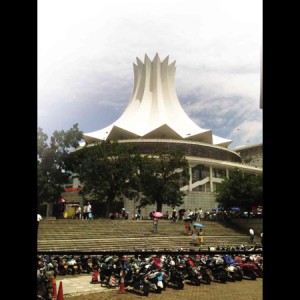‘Business is business’ despite sea row

THE Nanning International Convention & Exhibition Center is the permanent venue of the China-Asean Exposition (CAExpo). Photo by VOLT CONTRERAS
NANNING, China—There is at least one place in China each year where its long-standing maritime disputes with some of its Southeast Asian neighbors like the Philippines are set aside and replaced with gestures of goodwill—or, to be more precise, the handshakes of good business.
Most of them are made at the hibiscus-inspired architectural wonder of the city, the Nanning International Convention & Exhibition Center, permanent venue of the China-Asean Exposition (CAExpo), an annual trade and investments fair being staged for the 10th time in September.
The expo, launched in pageantry with high-level delegations from the host country and the Association of Southeast Asian Nations, is considered one of the concrete expressions of China’s economic openness and a main contact point for trade relations with the 10 Asean states.
Relations which, proponents say, transcend “political or historical problems” between China, the world’s second-biggest economy, and the Asean bloc, its major trading partner for products ranging from machinery, palm oil and minerals, to rubber and agricultural produce.
“Business is business,” said Hu Jianghua, a professor at Guangxi University of Finance and Economics, who recently spoke to Southeast Asian journalists as one of the experts tapped by the Chinese Ministry of Commerce to promote this year’s CAExpo at Nanning.
Dubbed the “Green City of China,” Nanning is the capital of the Guangxi Zhuang Autonomous Region, one of the growth areas in Southern China that are deemed most geographically strategic for investors from Southeast Asia.
Hu acknowledged that disputes, “including the South China Sea problem” (Manila calls the body of water West Philippine Sea), between China and some Asean countries could be an obstacle to economic cooperation.
“Actually, over the past two years we are promoting our economic and trade cooperation, we have seen the negative impact of some political issues and disputes between our two sides,” Hu said in a lecture.
“But the obstacles and problems posed by these issues are temporary. They will not be the permanent ones. In the long run, the permanent one will be the growth of bilateral economic and trade cooperation,” he said through an interpreter.
He made the remarks in response to a question on the Chinese decision in May 2012 to ban the importation of Philippine bananas supposedly because of pests. The ban, a move seen as an offshoot of escalating tensions on Scarborough Shoal, which is being claimed by the two nations, was lifted weeks later.
“I’m optimistic because both China and the majority of Asean member states are developing countries. We have a wide foundation for us to achieve our common concerns,” he said. “Although we see that sometimes the political issues and difficulties will affect negatively our economic and trade cooperation, we are confident that we have the wisdom and capability to solve them.”
Professor Hu cited people-to-people exchanges, missions on the department or legislative level, and relations among nongovernment and trade groups, as vehicles for continued cooperation.
This is because big economic numbers have long been at play, piling up year after year even as Chinese gunboats and Philippine tough talk made the bigger headlines.
As of April 2013, Chinese direct investments in Asean stood at $25.1 billion while Asean-based companies have poured a total of $79.8 billion into China, according to Li An, division director of the Department of Asian Affairs in the Ministry of Commerce.
Chinese interests in the region are mainly in mining, manufacturing, engineering, power and services.
Since China opened up its economy to the world under reforms initiated by leader Deng Xiaoping three decades ago, trade between China and Asean had increased nine-fold, from less than $900 million in 1978 to $8 billion in 2012, Li added.
Data from the Philippine Exporters Confederation Inc. (Philexport) showed that bilateral trade between China and the Philippines reached $36.37 billion in 2012, increasing 12.8 percent year on year.
The two countries also enjoyed two-way investments of $195 million. Philippine investments in China reached $130 million, while China invested $65.45 million in the country.
New project contracts signed by Chinese firms in the Philippines grew by 63.2 percent to $1.02 billion in 2012, Philexport said.
The CAExpo alone is given credit for generating trade between China and Asean to the tune of $13.5 billion as a result of last year’s fair. The first fair in 2004 resulted in a trade volume of $1.08 billion.
From only 626 Asean booths in 2004, the number grew to 9,204 in the last expo, where the Philippines promoted Clark Development Corp. and Poro Point Industrial Economic Zone.
“The objective of the CAExpo is to enhance bilateral friendly cooperation and economic and trade exchanges between China and Asean. The marine dispute is a problem that should be solved by the leaders of the countries concerned,” said Zheng Junjian, secretary general of CAExpo Secretariat.
“The CAExpo itself, with its practical and tangible outcomes, proves that only through friendly cooperation can we achieve future benefits, common development and win-win results,” Zheng stressed.
For comprehensive coverage, in-depth analysis, visit our special page for West Philippine Sea updates. Stay informed with articles, videos, and expert opinions.
